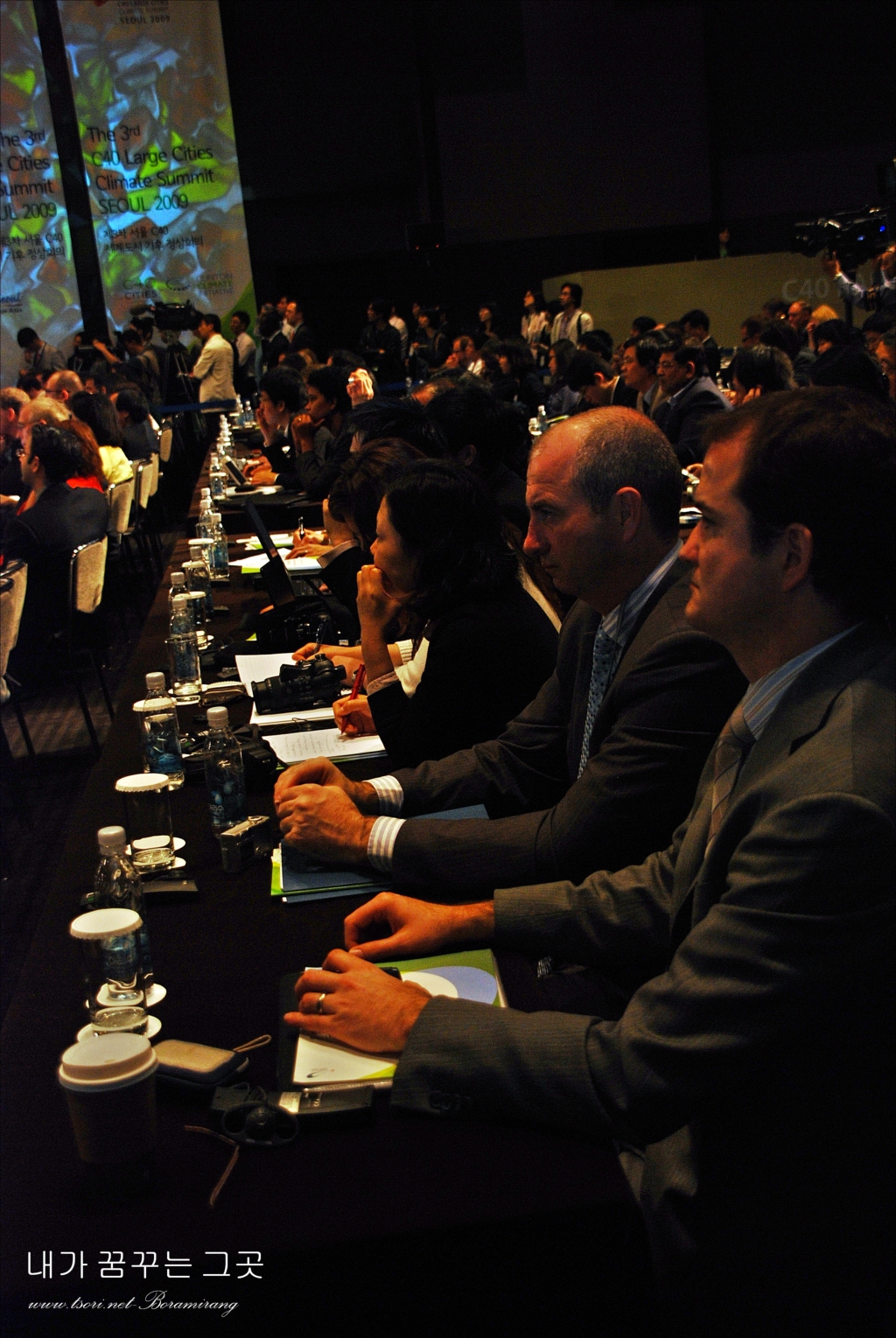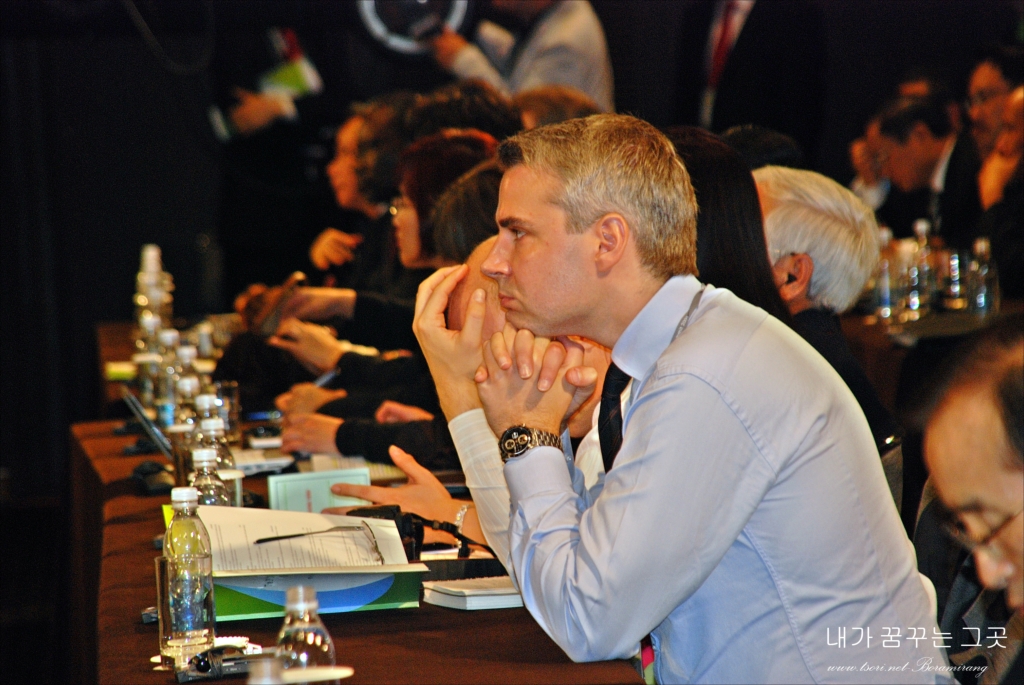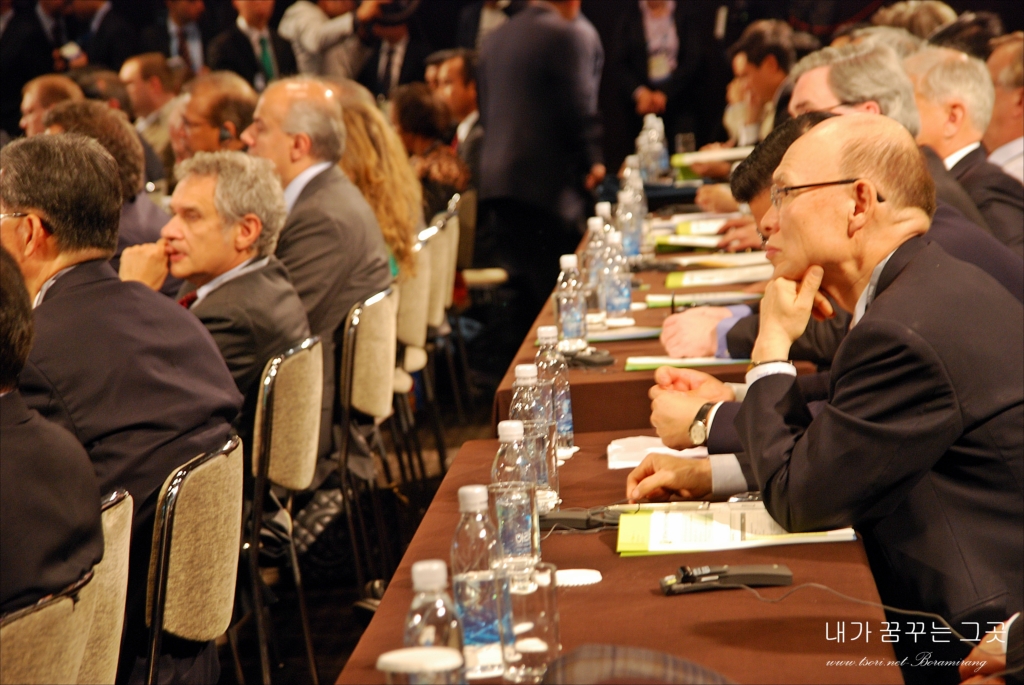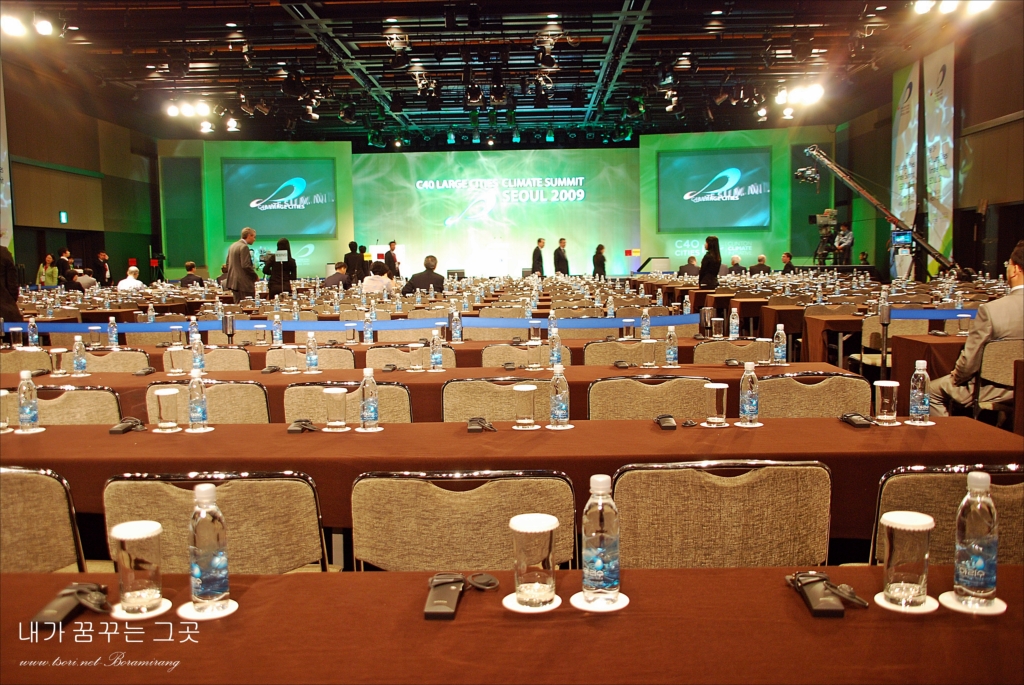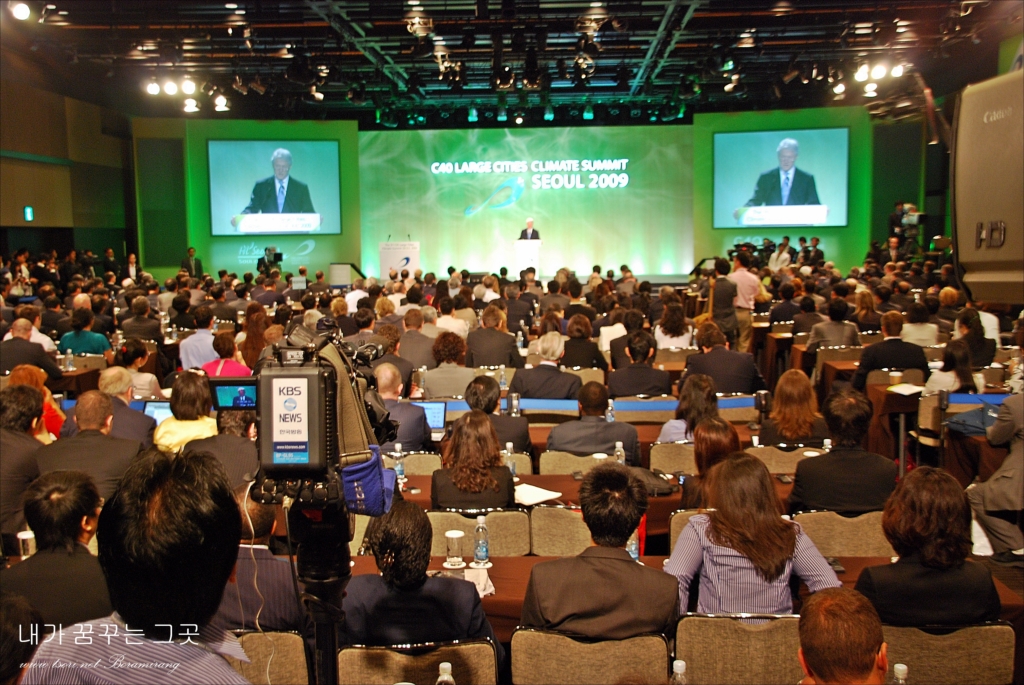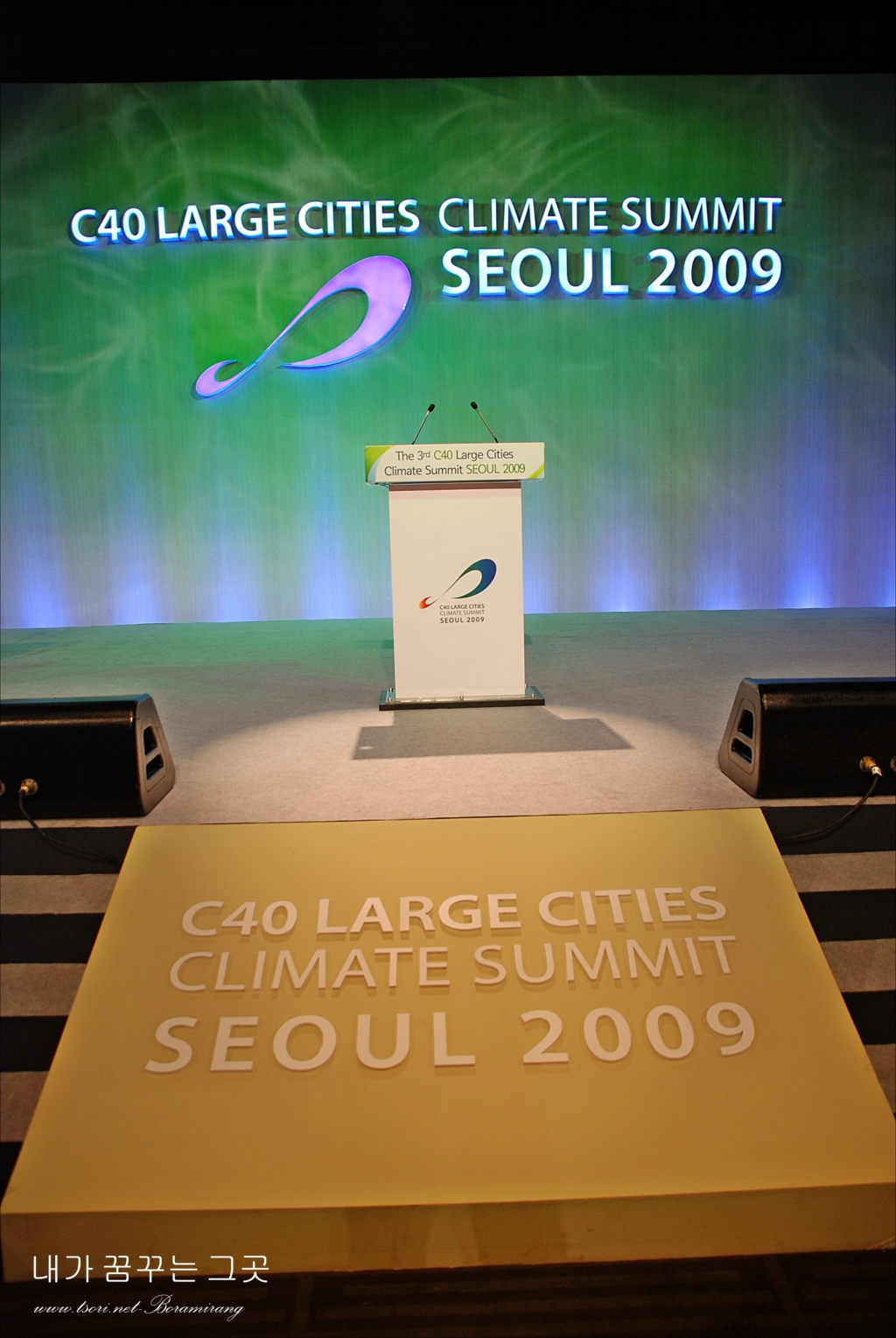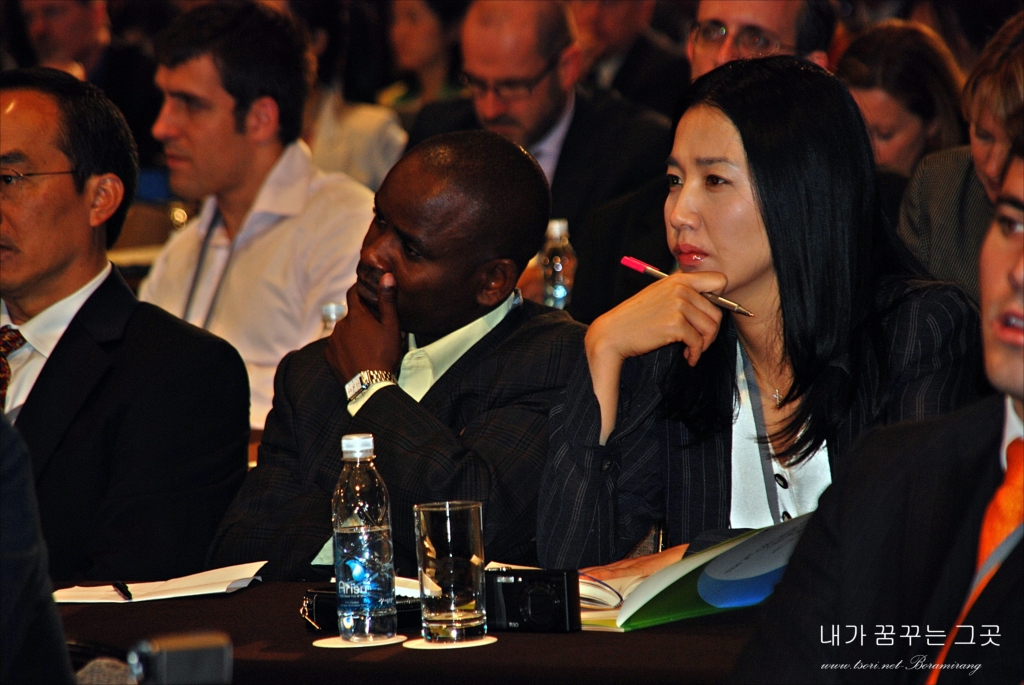|
-제3차 C40 세계도시기후정상회의-
서 울 선 언 문
C40 기후리더십그룹(이하 ‘그룹’) 제3차 정상회의에 참가한 C40도시
지도자와 대표단인 우리는
기후변화로 인해 전지구적 환경과 세계 인류의 삶이 심각한 위협에 직면하고 있으며, 이에 대응하기 위해 공존과 상생, 그리고 공통의 차별화된 책임의 원칙에 입각한 즉각적인 공동의 행동이 필요하다는 것에 인식을 같이 하며, 현재 세계인구의 50%이상이 세계 에너지의 75%를 소비하고 세계 온실가스의 80%를 배출하는 도시에 거주하고 있으며, 이러한 추세가 지속될 경우 2030년에는 세계 인구의 3분의 2 이상이 도시에 거주할 것으로 예상되며, 인구가 밀집된 도시와 그 시민들은 기후변화로 인해 주거와 교통, 물류 등 시민생활 양식의 근본적 변화에 직면하고 있고, 기상이변과 자연 재해 및 새로운 질병의 전파 등 다양한 위협요소에 노출되어 있으며, 도시들은 기후변화에 대한 책임을 지고 온실가스 감축과 기후변화에 대한 적응을 각 도시별로 즉각적이고 실질적인 대책을 수립집행하여야 하며, 또한 C40도시들이 전세계의 다른 도시들과 협력하여 모범사례와 기술을 공유하는 것이 매우 중요하며, 개발도상국의 도시들은 기후변화로 인한 위협에 더욱 취약하며 환경적 위협에 대처할 능력이 부족하기 때문에 선진국의 도시들은 개발도상국 도시들의 기후변화 대응노력을 지원하여야 한다는 점을 공감한다.
이러한 공통의 인식을 기반으로 우리는
C40도시의 온실가스 배출량을 최대한 감축하고, 불가피한 기후변화 현상에 적응하며, 기후변화에 대한 취약성을 보강하며 회복력을 증대시켜 각각의 도시를 Low- carbon City로 만들 것을 우리 공동의 목표로 선언한다.이 목표를 달성하기 위해 C40도시의 시정운영 및 도시계획 수립, 설계, 기반시설 구축 등 도시개발의 모든 과정에서 현재의 탄소배출 수준을 파악하고, 정책.프로그램.사업 등 가능한 방법을 통해 배출을 줄이며, 이미 이루어진 배출량의 영향을 없애기 위한 조치를 취할 것이다. C40도시들은 온실가스 배출을 분류하고 감시하며 각 도시들의 단계별 온실가스 감축목표 또는 정책, 구체적인 실행계획, 시간표가 포함된 기후변화 행동계획 (Climate Change Action Plan: CCAP)을 실행할 것이다. 대다수 C40도시들은 이미 기후변화 행동계획을 완료했으며 현재 계획을 검토보완하거나 새로운 CCAP를 수립 중인 C40도시들은 첨부된 부속서 (도시의 기후변화 대응을 위한 정책수단)에 제시된 방안을 고려할 것이다. 2011년 C40정상회의에는 CCAP 집행 성과에 대한 검토가 포함될 것이다. C40도시들은 C40사무국을 통한 특정기술의 획득에 대한 조정을 포함하여 저탄소 기술, 사업, 재원의 전파를 원활하게 하기 위해 적극적으로 협력할 것이다. C40도시들은 UNFCCC를 비롯한 국제기구, 국가정부, NGO, 친환경 기업 등과 목표와 경험의 공유, 공동사업, 자원의 지원 등 다양한 방법으로 협력 할 것이다. 우리는 온실가스 감축과 기후변화 대응을 위한 UNFCCC의 공통의 인식과 수단을 전파할 것을 약속한다. 2009년 12월 코펜하겐에서 열리는 제15차 당사국회의에서는 전세계적인 기후변화 대응 노력에서 도시의 선도적 역할이 인정받아야 한다. 회원도시를 포함한 모든 도시들이 온실가스 감축목표를 달성하고 기후변화를 멈추는데 함께 협력할 수 있도록 역할과 권한, 자원을 부여받아야 한다. 이 선언에서 발표한 내용의 성실한 이행을 위해 회원도시들은 기후 변화 대응을 전담하는 정책책임관을 지정하여 사무국에 통보하고, 각 도시들의 목표, 정책수단과 성과를 4차 총회 및 이후의 총회에서 보고할 것이다. C40 기후리더십 그룹은 각 도시와 그 시민들에게. 모든 인류와 미래 세대의 행복을 위해 기후변화의 위협에 대응하기 위한 노력을 더욱 강화할 것을 요청한다.2009년 5월 20일, 서울에서 개최된 C40 제3차 세계도시 기후 정상회의에서 이 선언을 채택한다.
C40 Large Cities Climate Summit SEOUL
18 –21 May 2009
Seoul Declaration
We, the government leaders and delegates of C40 cities,
Having met at the third Summit of the C40 Climate Leadership Group (hereinafter "Group") in Seoul,
Sharing the view that the earth and human beings are facing serious threats caused by climate change and that it is necessary to address these challenges by taking immediate and collective actions based on the principles of co-existence, mutual benefit, and common but differentiated responsibilities.
Recognising that at present over 50% of the world’s population lives in cities,which now account for 75% of global energy consumption and 80% of global greenhouse gas emissions and at this rate, by 2030, two thirds of the world’s population is predicted to live in urban areas,
Further recognising that densely populated cities and their citizens are facing fundamental lifestyle changes in the areas of housing, transportation, and other services, and, at the same time, are exposed to numerous threats, including extreme weather events, natural disasters and newly emerging diseases,
Reaffirming that cities must take responsibility for their contribution to climate change, and establish and implement immediate and practical measures for the mitigation of greenhouse gas emissions and adaptation to the threats caused by climate change at the individual city level,
Further reaffirming that it is important for C40 cities to cooperate with all cities around the world and share best practice and technologies, and that cities in developed countries need to assist the efforts of cities in developing countries in taking actions as they are more vulnerable to climate change and have lower capacity to cope with environmental hazards,
Proclaim that:
C40 cities hereby set a common goal of transforming themselves into low-carbon cities, by cutting greenhouse gas emissions to the largest extent possible, by adapting themselves to the unavoidable climate change consequences, by making cities less vulnerable to climate change, and by enhancing cities’ capacity for remediation.
C40 cities identify their current level of carbon emissions from all city operations and stages of community development including urban planning, design and infrastructure building. Cities reduce emissions wherever possible through policies, programmes and projects and takingsteps to negate the impact of remaining emissions.
C40 cities continue to catalogue and monitor their greenhouse gas emissions and implement Climate Change Action Plans. C40 cities include measures or targets for greenhouse gas reductions and specific policies, projects and programmes with a schedule for implementation wherever possible. The majority of C40 cities have already completed Climate Change Action Plans. C40 cities that are reviewing existing plans or
developing new Climate Change Action Plans are asked to consider the measures presented in the attached Annex: Policies and Measures to Address Climate Change. The 2011 C40 Summit will include a review of progress on the implementation of Climate Change Action Plans.
C40 cities actively work together to accelerate delivery of low-carbon technologies, programmes and financing, including through active coordination in procurement of specific technologies through the C40 Secretariat.
C40 cities work collaboratively with the United Nations Framework Convention on Climate Change (UNFCCC) and other international bodies, national governments, non-governmental organisations, and eco-friendly businesses, including sharing goals and experiences and, in some instances, engaging in joint projects, and providing resources. We are committed to delivering common awareness and measures outlined in the UNFCCC to reduce greenhouse gas emissions and tackle climate change
In the run up to the COP15 United Nations Climate Change Conference in Copenhagen in December 2009, the leading role of cities in the global effort against climate change must be recognised. C40 cities and all cities with shared goals, must be engaged, empowered and resourced, so that cities can work together to deliver on greenhouse gas reduction targets and stop climate change.
Cities will notify the C40 Secretariat of the names of staff in charge of climate change policies and programmes to enhance implementation of various action items set forth in this Declaration, as well as report on their established measures, targets and achievements at the 4th C40 Summit and subsequent summits
The C40 Climate Leadership Group calls upon cities and their citizens to exert their efforts to address the threats caused by climate change for the benefit of all the people and future generations.
Adopted on May 21, 2009, at the 3rd C40 Large Cities Climate Summit, held in Seoul Korea
Annex
Policies and Measures to Address Climate Change in Cities
To tackle climate change, cities shall adopt and implement policies and measures most suitable to their circumstances. It is important that C40 cities cooperate with all cities around the world and share best practices and technologies. The Clinton Climate Initiative has developed a Measurement Tool that each C40 city can use to calculate a baseline inventory of current emissions. The tool will also allow cities to track progress on their climate change goals.
In establishing their own Climate Change Action Plans, cities will give preferential consideration to the following measures proven to be effective in many cities.
1. To take a systematic and secure approach, take institutional measures such as enacting city ordinances based on technical studies, engaging in long-term planning, and establishing Climate Change Funds.
2. To avoid, mitigate, or delay the impact of climate change by reducing greenhouse gas emissions:
i.adopt eco-friendly architectural design guidelines for construction, lighting, and insulation, etc., introduce a new and renewable energy certification, prescribed ratio of new and renewable energy for new and renovated buildings, and promote eco-friendly buildings and rationalise energy consumption by providing incentives for energy-efficient designs;
ii.establish a sustainable transport system through policies that favour public transit and encourage the use of bicycles, promote sustainable land-use and urban design, including preserving natural landscape, continuous expansion of green areas and other eco-spaces and conduct urban planning with focus on low-energy consumption;
Iii.expand citywide resource reclamation and reuse facilities and promote recycling programmes, and
iv.raise the share of new and renewable energy in the total energy mix.
3. To adapt cities to the unavoidable climate change consequences, providing citizens with a secure environment and higher quality of life by conducting forecasting analysis and thus minimisingthe damages caused by climate change:
i.prepare for disasters by building infrastructure and establishing management plans that will protect citizens against extreme weather events;
ii. nsure networks such as disaster information systems and weather observation facilities are in place ;
iii.prepare measures to protect population groups most vulnerable to intense heat waves and improve the monitoring and control systems for communicable and other diseases;
iv.strengthen ability to anticipate changes in the urban eco-system, improve monitoring of air and other types of pollution, and enhance early warning systems
v.improve energy demand management, such as ability to forecast and respond to fluctuations in seasonal energy demands;
vi.reflect climate change impacts, such as heat island effects, in the urban planning process; and
vii.improve water resource management.
4. To promote the engagement of city residentsto address climate change effectively:
i.providetools for measuring individual carbon footprints and the amount of emission generated by normal, daily activities of citizens;
ii.develop and promote practical ways for a low-carbon lifestyle,
iii.support activities of civic organisations to tackle climate change.
iv.Promote environmental educational policies to prepare next generations for climate change and to think on what citizens can do to develop a sustainable lifestyle and mitigate greenhouse gas emissions
** 아울러 정책방향을 담은 '도시의 기후변화 대응을 위한 정책수단'에는 클린턴기후구상 (Clinton Climate Initiative: CCI)이 포함된 부속서가 있는데요. 지면관계상 생략하기로 하겠습니다. 장시간 할애하여 포스팅 읽어주셔서 깊은 감사드립니다. 아마 이 포스팅을 보시는 것도 기후변화 행동의 하나 겠죠? ^^*
| ![]() Boramirang
Boramirang  MB583 미디어 블로그 - 1인 미디어 연합
MB583 미디어 블로그 - 1인 미디어 연합 네이버에서 구독 ※ 마우스를 올려놓고 휠을 사용해 보세요
네이버에서 구독 ※ 마우스를 올려놓고 휠을 사용해 보세요 
